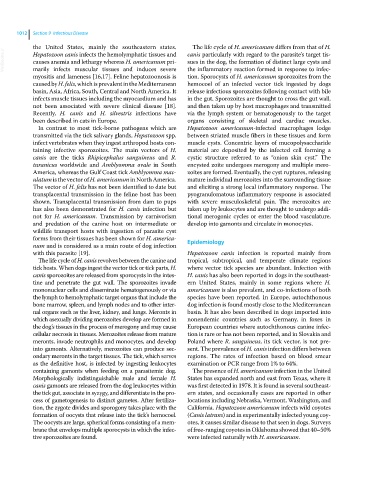Page 1074 - Clinical Small Animal Internal Medicine
P. 1074
1012 Section 9 Infectious Disease
the United States, mainly the southeastern states. The life cycle of H. americanum differs from that of H.
VetBooks.ir Hepatozoon canis infects the hemolymphatic tissues and canis particularly with regard to the parasite’s target tis-
sues in the dog, the formation of distinct large cysts and
causes anemia and lethargy whereas H. americanum pri-
marily infects muscular tissues and induces severe
tion. Sporocysts of H. americanum sporozoites from the
myositis and lameness [16,17]. Feline hepatozoonosis is the inflammatory reaction formed in response to infec-
caused by H. felis, which is prevalent in the Mediterranean hemocoel of an infected vector tick ingested by dogs
basin, Asia, Africa, South, Central and North America. It release infectious sporozoites following contact with bile
infects muscle tissues including the myocardium and has in the gut. Sporozoites are thought to cross the gut wall,
not been associated with severe clinical disease [18]. and then taken up by host macrophages and transmitted
Recently, H. canis and H. silvestris infections have via the lymph system or hematogenously to the target
been described in cats in Europe. organs consisting of skeletal and cardiac muscles.
In contrast to most tick‐borne pathogens which are Hepatozoon americanum‐infected macrophages lodge
transmitted via the tick salivary glands, Hepatozoon spp. between striated muscle fibers in these tissues and form
infect vertebrates when they ingest arthropod hosts con- muscle cysts. Concentric layers of mucopolysaccharide
taining infective sporozoites. The main vectors of H. material are deposited by the infected cell forming a
canis are the ticks Rhipicephalus sanguineus and R. cystic structure referred to as “onion skin cyst.” The
turanicus worldwide and Amblyomma ovale in South encysted zoite undergoes merogony and multiple mero-
America, whereas the Gulf Coast tick Amblyomma mac- zoites are formed. Eventually, the cyst ruptures, releasing
ulatum is the vector of H. americanum in North America. mature individual merozoites into the surrounding tissue
The vector of H. felis has not been identified to date but and eliciting a strong local inflammatory response. The
transplacental transmission in the feline host has been pyogranulomatous inflammatory response is associated
shown. Transplacental transmission from dam to pups with severe musculoskeletal pain. The merozoites are
has also been demonstrated for H. canis infection but taken up by leukocytes and are thought to undergo addi-
not for H. americanum. Transmission by carnivorism tional merogonic cycles or enter the blood vasculature,
and predation of the canine host on intermediate or develop into gamonts and circulate in monocytes.
wildlife transport hosts with ingestion of parasite cyst
forms from their tissues has been shown for H. america- Epidemiology
num and is considered as a main route of dog infection
with this parasite [19]. Hepatozoon canis infection is reported mainly from
The life cycle of H. canis revolves between the canine and tropical, subtropical, and temperate climate regions
tick hosts. When dogs ingest the vector tick or tick parts, H. where vector tick species are abundant. Infection with
canis sporozoites are released from sporocysts in the intes- H. canis has also been reported in dogs in the southeast-
tine and penetrate the gut wall. The sporozoites invade ern United States, mainly in some regions where H.
mononuclear cells and disseminate hematogenously or via americanum is also prevalent, and co‐infections of both
the lymph to hemolymphatic target organs that include the species have been reported. In Europe, autochthonous
bone marrow, spleen, and lymph nodes and to other inter- dog infection is found mostly close to the Mediterranean
nal organs such as the liver, kidney, and lungs. Meronts in basin. It has also been described in dogs imported into
which asexually dividing merozoites develop are formed in nonendemic countries such as Germany, in foxes in
the dog’s tissues in the process of merogony and may cause European countries where autochthonous canine infec-
cellular necrosis in tissues. Merozoites release from mature tion is rare or has not been reported, and in Slovakia and
meronts, invade neutrophils and monocytes, and develop Poland where R. sanguineus, its tick vector, is not pre-
into gamonts. Alternatively, merozoites can produce sec- sent. The prevalence of H. canis infection differs between
ondary meronts in the target tissues. The tick, which serves regions. The rates of infection based on blood smear
as the definitive host, is infected by ingesting leukocytes examination or PCR range from 1% to 64%.
containing gamonts when feeding on a parasitemic dog. The presence of H. americanum infection in the United
Morphologically indistinguishable male and female H. States has expanded north and east from Texas, where it
canis gamonts are released from the dog leukocytes within was first detected in 1978. It is found in several southeast-
the tick gut, associate in syzygy, and differentiate in the pro- ern states, and occasionally cases are reported in other
cess of gametogenesis to distinct gametes. After fertiliza- locations including Nebraska, Vermont, Washington, and
tion, the zygote divides and sporogony takes place with the California. Hepatozoon americanum infects wild coyotes
formation of oocysts that release into the tick’s hemocoel. (Canis latrans) and in experimentally infected young coy-
The oocysts are large, spherical forms consisting of a mem- otes, it causes similar disease to that seen in dogs. Surveys
brane that envelops multiple sporocysts in which the infec- of free‐ranging coyotes in Oklahoma showed that 40–50%
tive sporozoites are found. were infected naturally with H. americanum.

